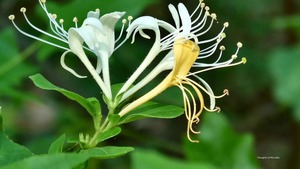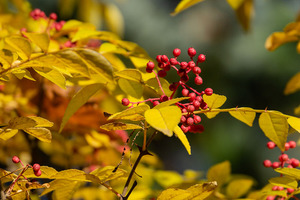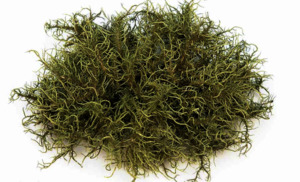Herbal Immunity Boosters are type of herb that can only be used in the short-term when you’re in desperate need to stimulate your white blood cells. It is mostly advised that they are used in the developing stages of an illness or when you have been exposed to a contagious infection. They might be a quick fix, but they will not fight infection for the entire duration of an illness. Therefore, they need to be administered regularly to keep their levels topped up in the body.
Honeysuckle(Lonicera)
This miracle herb has a vast list of advantages. It has antiviral, antibacterial, decongestant, astringent, and diuretic properties in addition to being an immunostimulant. It’s also an excellent antioxidant with anti-inflammatory qualities. Honeysuckle provides excellent treatment from colds and flus, as well as illnesses affecting the throat and lungs such as tonsillitis, laryngitis, pneumonia, and bronchitis.
Despite the fact that it is a powerful healer, you may mistakenly believe that you must seek it out from a specialised or expensive herbalist. While consulting a professional is recommended, honeysuckle does not have to be difficult to find or expensive to purchase. In fact, it grows freely in North America, to the point where some people consider it a nuisance!
It’s usually found deep within thickets, forests, and pastures, or even along the side of the road. You can also grow honeysuckle in your garden, but be aware that it will quickly take over your space.

honeysuckle syrup
It couldn’t be any easier to take honeysuckle. If you have sugar in your cupboard and access to water, you’ll be able to make your own syrup in no time.
Add 2 cups of water to a pan and add 1 cup of fresh honeysuckle flowers.
Next, bring the water to a boil. As soon as the mixture reaches boiling point, lower the heat and let it simmer gently.
Strain the mixture once it has reduced to half the amount of water in the pan and set the flowers aside. You should now have flower-infused water to which you may add the sugar. You can add as much or as little sugar as you desire, but a cup of sugar of your choice is recommended.
Stir the mixture vigorously and pour into a jar to be refrigerated.
Kept chilled, it can be preserved for up to 6 months.
The syrup can be consumed as per convenient. For example, you may choose to sweeten desserts with it or pour it over waffles or pancakes. You can even bake with it or use it as a replacement for honey. Or you can use it as a sugar substitute for sweetening tea.
honeysuckle tincture
If a sweet syrup isn’t your thing, try making a tincture instead. It’s really simple to create and only requires three ingredients: Honeysuckle flowers, Vodka or any strong alcohol and a glass jar.
Preparation
Fill your vase with honeysuckle blooms. You can use as many as you want, but a cup’s worth is a fine starting point.
Cover the blooms in your preferred alcoholic beverage.
Allow for at least 4 weeks of resting time. The tincture will become more strong the longer you leave it. If you don’t want to wait four weeks, shake the jar once a day to “activate” the blossoms and speed up the process. This will ensure that the compounds from the flowers are fully absorbed into the vodka.
Prickly Ash (Zanthoxylum americanum)
Because of its adaptability and potency, this plant has always been popular in the world of herbal therapy. Prickly ash, like many herbal medicines, has a role in Native American culture, where it was used to cure stomach cramps, skin diseases, and sore throats. It was also employed as a means of boosting saliva production. During the 1800s, doctors would give prickly ash to their patients to help with digestive problems and constipation.
It was also utilised to give the immune system a much-needed boost during times when disease was widespread. This was particularly true during the cholera outbreak. Another application for prickly ash is as a toothache numbing medication. This is due to the presence of an alkamide termed herculin, as well as alkaloids. This means that it will cause numbness when applied to a specific region, such as an aching tooth. This is why the plant is also known as the Toothache Tree in some areas. Chewing on the twigs can be used to apply it to the area, or it can be ground into a powder and dusted along the gum line or directly into the tooth.

The bark and berries of the prickly ash plant are usually used to make a tincture. Alternatively, in tea form for those courageous enough to risk a tingle mouth.
Taken in very small doses, it can work as a feel-good tonic that gently boosts the immune system while adding some much needed movement and energy to the lymphatic system.
There are three methods to take prickly ash if you think it’s right for you. Prickly ash powder is available in tablet form and is a popular approach to receive a high concentration of its active components with low effort. Doses can range from 250mg to 750mg, depending on the condition being treated. As a result, always consult a specialist to determine the appropriate dosage for you.
If tea is more to your taste, you can simmer 1 teaspoon of prickly ash bark in hot water for 15-20 minutes. Drink one cup twice a day.
Caution: One thing that should be noted about prickly ash is that although it can be a wonderful remedy, It can also counteract anticoagulant medication such as blood thinners. And it must never be used if you are pregnant or breastfeeding
Usnea (Beard lichens)
It was used in Ancient Egypt, Greece and China and its popularity has remained steady for almost 3000 years. It was traditionally used to cure indigestion, but recent study has revealed that it can also help with common colds, coughs, and sore throats. This is due to its antibacterial characteristics as well as the presence of mucilage, which is highly beneficial in the treatment of coughs. Furthermore, there is evidence that it can directly combat microorganisms. That means those nasty tiny bacteria can be eliminated before they can cause any harm.

usnea tincture
Ingredients: Fresh usnea (about 1 cup is recommended), Alcohol with at least 40% alcohol content, Something to grind your usnea with such as a mortar and pestle or a coffee grinder, a glass jar and a crock pot.
Preparation:
Firstly, take your usnea and grind it.
place the powder into your jar and pour over your alcohol of choice making sure all of the powder is covered.
It’s now time to turn on your crock pot. Place your jar in the centre and cover it with water after turning it on to the lowest heat setting.
leave it for around 3-4 days.
After your 3-4 days are finished your tincture is ready. All you have to do now is strain the usnea from the alcohol.
however, also use a coffee filter if you prefer.
To be Continued
Source: Text Book of Herbal Medicine, Google

